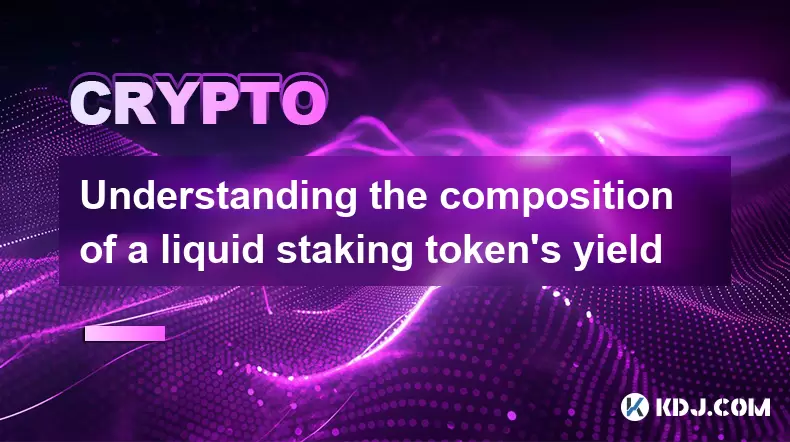-
 bitcoin
bitcoin $107015.826941 USD
-2.18% -
 ethereum
ethereum $3637.352324 USD
-5.18% -
 tether
tether $0.999831 USD
-0.02% -
 xrp
xrp $2.338078 USD
-6.23% -
 bnb
bnb $998.272150 USD
-6.97% -
 solana
solana $167.598257 USD
-10.12% -
 usd-coin
usd-coin $0.999863 USD
0.01% -
 tron
tron $0.282573 USD
-5.09% -
 dogecoin
dogecoin $0.169891 USD
-7.39% -
 cardano
cardano $0.557554 USD
-7.03% -
 hyperliquid
hyperliquid $39.914802 USD
-5.85% -
 chainlink
chainlink $15.414549 USD
-9.97% -
 bitcoin-cash
bitcoin-cash $510.361911 USD
-4.26% -
 ethena-usde
ethena-usde $0.999194 USD
-0.03% -
 stellar
stellar $0.282092 USD
-6.07%
How to mitigate risks in liquid staking
Liquid staking lets you earn rewards while keeping assets liquid, but risks like smart contract flaws, slashing, and token volatility require careful platform selection and diversification.
Jul 25, 2025 at 03:43 pm

Understanding Liquid Staking and Its Inherent Risks
Liquid staking is a process that allows users to stake their cryptocurrency assets while retaining liquidity through the issuance of a tokenized version of their staked assets. This innovation has gained popularity in the DeFi space, especially on networks like Ethereum, Cosmos, and Solana. However, liquid staking comes with risks such as smart contract vulnerabilities, slashing penalties, and price volatility of the derivative tokens. Understanding these risks is crucial before engaging in any staking activity.
One of the most significant risks is the smart contract risk associated with the platforms offering liquid staking services. If the code has vulnerabilities, attackers may exploit them, leading to loss of funds. Additionally, slashing — a penalty applied when a validator misbehaves — can reduce the value of staked assets. Lastly, the volatility of liquid staking derivatives, such as stETH or bETH, can cause unexpected losses if the peg to the original asset breaks.
Choosing a Reputable Liquid Staking Provider
Selecting a trustworthy platform is one of the first steps in mitigating risks. Not all liquid staking providers are created equal, and some may lack transparency or have weak security protocols. Researching the team, code audits, and on-chain performance of the platform should be a priority.
- Look for platforms that have undergone multiple third-party audits by reputable firms like Trail of Bits or CertiK.
- Check if the provider has a transparent governance model and a track record of handling incidents responsibly.
- Review the historical performance of their staking derivatives to assess stability and reliability.
Diversifying Staking Assets Across Multiple Platforms
Putting all your staked assets into a single liquid staking platform increases exposure to platform-specific risks. Diversification across multiple providers can help reduce the impact of a single point of failure.
- Spread your staking across different protocols like Lido, Rocket Pool, and Stakehound to reduce dependency on one system.
- Consider using non-custodial staking solutions where you retain control of your validator keys.
- Monitor each platform’s TVL (Total Value Locked) and slashing incidents to adjust your allocation accordingly.
Monitoring Smart Contract Risks and Security Updates
Smart contracts are the backbone of liquid staking platforms, but they are also a major attack vector. Keeping track of contract upgrades, audit reports, and security advisories is essential for risk mitigation.
- Subscribe to the official communication channels of your chosen platform for real-time updates on contract changes.
- Use tools like Blockchair or Etherscan to verify contract addresses and check for known vulnerabilities.
- Stay informed about past exploits on similar platforms to understand potential weaknesses.
Managing Slashing Risks Through Validator Selection
Slashing occurs when a validator node behaves maliciously or fails to perform its duties. While most liquid staking platforms pool validators, users can still take steps to minimize slashing exposure.
- Opt for platforms that use decentralized validator sets rather than relying on a few centralized entities.
- Check if the platform implements slashing insurance or compensation mechanisms for users.
- Avoid platforms with a high rate of validator downtime or a history of frequent slashing events.
Frequently Asked Questions
Q: What is the difference between traditional staking and liquid staking?A: Traditional staking locks up your assets for the duration of the staking period, while liquid staking provides a tokenized version of your staked assets, allowing you to retain liquidity and participate in DeFi activities.
Q: Can I lose money with liquid staking even if I don’t get slashed?A: Yes, due to the volatility of staking derivatives and potential depegging events, it is possible to experience losses even without slashing penalties.
Q: Are there insurance options for liquid staking?A: Some platforms offer slashing insurance or risk mitigation funds, but coverage varies. It’s important to review the specific terms and conditions of each provider.
Q: How can I track the performance of my liquid staking assets?A: Use blockchain explorers like Etherscan or platform-specific dashboards to monitor rewards, validator performance, and derivative token balances in real time.
Disclaimer:info@kdj.com
The information provided is not trading advice. kdj.com does not assume any responsibility for any investments made based on the information provided in this article. Cryptocurrencies are highly volatile and it is highly recommended that you invest with caution after thorough research!
If you believe that the content used on this website infringes your copyright, please contact us immediately (info@kdj.com) and we will delete it promptly.
- Bittensor's Wild Ride: TAO Token's Volatile Moves Explained
- 2025-11-05 05:20:02
- Decoding Crypto's Wild Ride: Insights on Bitcoin, XRP, and the Future of Digital Assets
- 2025-11-05 05:30:01
- ASTER Crash, Binance & Market Chaos: Decoding Crypto's Wild Ride
- 2025-11-05 05:30:02
- BNB Price Plunge: Crypto Sell-Off Deepens, What's Next?
- 2025-11-05 05:50:13
- Unlocking Crypto's Future: NIP Group's Bitcoin Bet, Altcoin Liquidity Boost, and the Rise of Little Pepe
- 2025-11-05 05:50:13
- Backend-for-Frontend, Token Theft, and Security: Navigating the Treacherous Waters of Modern Web Apps
- 2025-11-05 05:10:01
Related knowledge

Understanding the composition of a liquid staking token's yield
Jul 20,2025 at 09:07am
What Is a Liquid Staking Token?A liquid staking token is a representative asset issued to users who stake their native cryptocurrency on a proof-of-st...

Is it better to stake directly or use a liquid staking service?
Jul 22,2025 at 08:21pm
Understanding the Basics of StakingStaking in the context of blockchain and cryptocurrency refers to the process of locking up digital assets to suppo...

What to do during an LST depeg event
Jul 20,2025 at 04:57pm
Understanding LST Depeg EventsAn LST (Liquid Staking Token) depeg event occurs when the token, which is typically pegged to the value of the underlyin...

How to find new liquid staking projects
Jul 30,2025 at 01:14pm
Understanding Liquid Staking and Its ImportanceLiquid staking is a mechanism that allows users to stake their cryptocurrency assets while still mainta...

Can you provide liquidity with liquid staking tokens?
Jul 22,2025 at 10:22am
Understanding Liquid Staking TokensLiquid staking tokens (LSTs) are derivative tokens that represent staked assets on a proof-of-stake (PoS) blockchai...

What are the best wallets for storing LSTs?
Jul 21,2025 at 03:14pm
Understanding LSTs and the Need for Secure StorageLSTs, or Liquid Staking Tokens, are derivative tokens representing staked assets on a blockchain. Wh...

Understanding the composition of a liquid staking token's yield
Jul 20,2025 at 09:07am
What Is a Liquid Staking Token?A liquid staking token is a representative asset issued to users who stake their native cryptocurrency on a proof-of-st...

Is it better to stake directly or use a liquid staking service?
Jul 22,2025 at 08:21pm
Understanding the Basics of StakingStaking in the context of blockchain and cryptocurrency refers to the process of locking up digital assets to suppo...

What to do during an LST depeg event
Jul 20,2025 at 04:57pm
Understanding LST Depeg EventsAn LST (Liquid Staking Token) depeg event occurs when the token, which is typically pegged to the value of the underlyin...

How to find new liquid staking projects
Jul 30,2025 at 01:14pm
Understanding Liquid Staking and Its ImportanceLiquid staking is a mechanism that allows users to stake their cryptocurrency assets while still mainta...

Can you provide liquidity with liquid staking tokens?
Jul 22,2025 at 10:22am
Understanding Liquid Staking TokensLiquid staking tokens (LSTs) are derivative tokens that represent staked assets on a proof-of-stake (PoS) blockchai...

What are the best wallets for storing LSTs?
Jul 21,2025 at 03:14pm
Understanding LSTs and the Need for Secure StorageLSTs, or Liquid Staking Tokens, are derivative tokens representing staked assets on a blockchain. Wh...
See all articles










































































